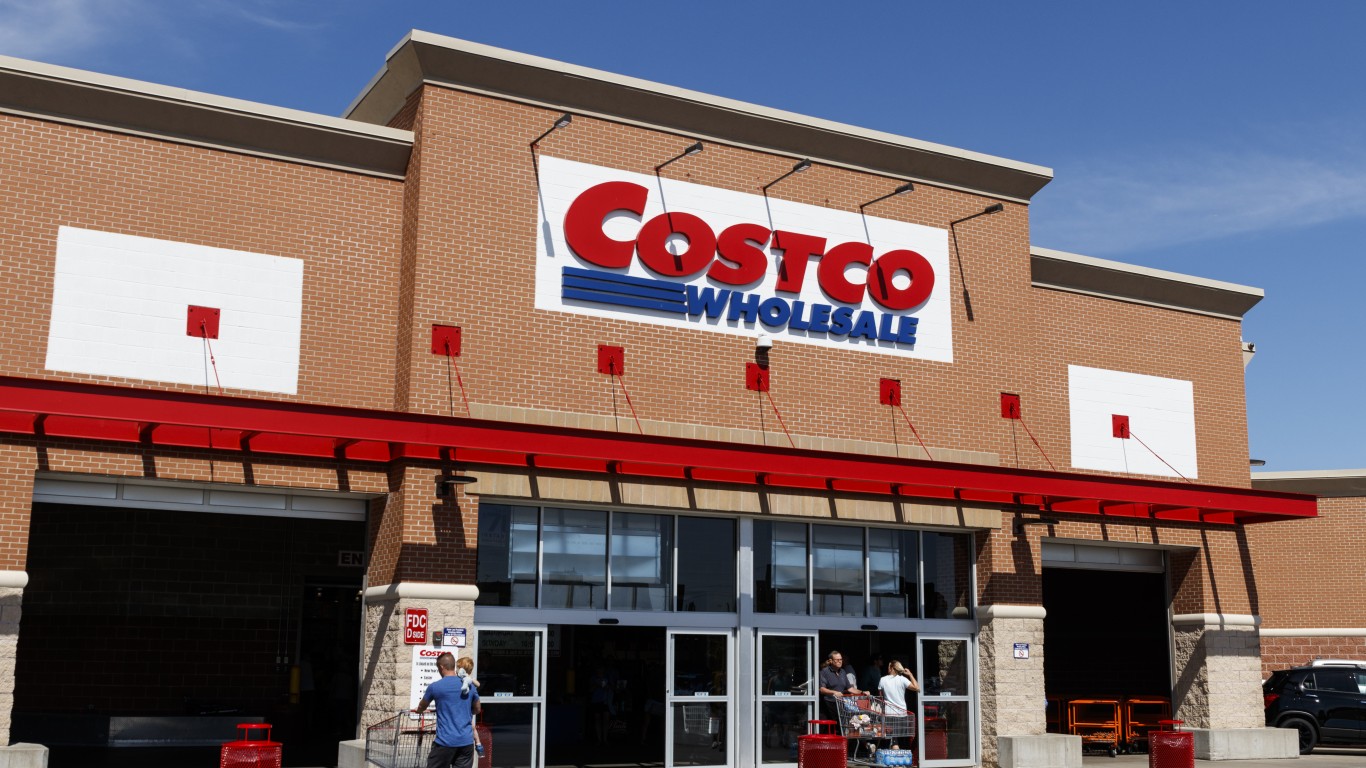Whole Foods Market, Inc. (NASDAQ: WFM) has been gutted yet again after its earnings report. The company has been facing serious competition from traditional grocery chains and has more upstarts and natural or organic grocers that offer some of the same or comparable goods at lower prices. Source: courtesy of Whole Foods Market
Source: courtesy of Whole Foods Market
The reality is that Whole Foods’ earnings story may represent the death of that long-term growth story.
24/7 Wall St. is looking also at what analysts on Wall Street have had to say. As you might imagine, it isn’t all that pretty.
What investors have to consider now is that this represents a double capitulation from analysts and investors alike. The investors feel duped, and the analysts just cannot stand by their prior targets as those acceptable earnings multiples have to become more normalized. In short, Whole Foods doesn’t deserve its premium valuation at the same level that it did in prior years.
Companies lose favor with investors and analysts alike when the develop a pattern of having seriously weaker earnings reports. Then you have to consider that Whole Foods still has a premium market value versus traditional grocery stores as well. With same store sales not even growing 2%, and with a warning that same-store sales may dip into the red, what else would you expect?
Analyst coverage has been given in a brief summary first, followed by the actual earnings and guidance, and then by more details from several of the research reports. Additional analyst coverage has been set below:
- BofA Merrill Lynch kept its Neutral rating but cut the price objective down to $41 from $45;
- BMO Capital Markets has a Market Perform rating but cut its price target down to $35 from $45;
- Canaccord Genuity downgraded it to Hold from Buy and cut its price target to $38 from $51;
- Credit Suisse kept its Neutral rating but cut its target price to $35 from $40;
- Morgan Stanley downgraded it to Equal Weight from Overweight and slashed the price target down to $37 from $56;
- Oppenheimer kept its Outperform rating but cut the target price to $45 from $48, and it had lowered its price target $2 from $50 just days ahead of earnings;
- RBC Capital Markets kept its Outperform rating but lowered the target price to $46 from $51;
- S&P Capital IQ maintained its Hold rating and cut the target price to $42 from $47;
- Sterne Agee CRT downgraded it to Neutral from Buy, and slashed its price target down to $37 from $55.
- SunTrust Robinson Humphrey kept its Buy rating but cut its price target to $45 from $55;
- Telsey Advisory Group kept a Market Perform rating and lowered its price target to $40 from $47;
- Wedbush Securities lowered its rating to Neutral from Outperform.
ALSO READ: Has Facebook’s Value Peaked?
More detailed analysis from several key research reports and the earnings summary is included below.
The organic and natural foods grocer had $0.43 in earnings per share (EPS) on $3.63 billion in revenue versus consensus estimates from Thomson Reuters that call for $0.45 in EPS on $3.69 billion in revenue. The same period in the previous year had $0.41 in EPS on $3.38 billion.
The company gave guidance in terms of targets for the 2015 fiscal year. Whole Foods expects sales growth 9%, with comparable store sales in the low single digits, and return on invested capital (ROIC) over 14%. There are consensus estimates of $1.72 in EPS on $15.59 billion in revenue for the 2015 fiscal year.
Again, more detailed analysis is below.
BofA Merrill Lynch’s Robert F. Ohmes and Marisa Sullivan said:
Given expectations for continued same-store sales and gross margin pressures (from Whole Foods’ value efforts and reduced occupancy cost leverage), we are lowering our price objective to $41 from $45, which is based on 20x our F17E EPS of $2.05. We remain Neutral as we believe its new concept may help its efforts to appeal to a broader customer demographic but see greater uncertainty over the growth outlook for Whole Foods’ core business.
Canaccord Genuity’s Scott Van Winkle said:
We are lowering our rating to Hold from Buy as comparable growth is now approaching zero under the weight of the competitive environment, perception of Whole Foods’ value proposition and price investment that has not yielded the results we anticipated. With revenue and EPS growth now further challenged, a forward P/E still well north of 20, the potential for negative comparable sales looming ahead and any early read on the new 365 by Whole Foods format roughly a year away, we move to the sidelines… While a different economic cycle, the forward PE hit mid-teens in anticipation of the last, and only prior period of negative comps in 2008. As such, the risk/reward doesn’t look favorable even after the recent correction.
Credit Suisse’s analyst report said:
The disappointment was driven mostly by a weaker than expected comp of +1.3%, which unfavorably compared to consensus of +2.9%. While the result was better excluding the Easter shift and the cycling of a promotional campaign in the prior year, trends decelerated significantly in the five weeks ended July 26 (up only about 50 bps) as the NYC pricing issue garnered national media attention. The gross margin slipped 66 bps (also a bit worse than expected) as price investment and higher shrink pressured profitability. Cost control was better than expected. Q4 guidance (if comps stay at the current level) was also short of consensus. Overall, we believe the Q3 update only solidified growing concerns about competition and the company’s price position.
Ultimately, we believe management may be forced to invest in price faster than it would like and cut back on its growth target in its core concept. The 365 stores at this point are unproven and the launch only creates further uncertainty regarding the strategy. The stock should trade off materially once again, but we do not see this weakness as a buying opportunity. We cut our target price to $35 from $40.
S&P Capital IQ’s J. Agnese said:
We cut our 12-month target $5 to $42, applying a P/E of 23X, a sector average 2.3X our estimated 3-year EPS growth rate of 10%, to our FY 16 (Sep.) EPS estimate of $1.81, down from $1.94. We reduce our FY 15 EPS estimate $0.04 to $1.68. Jun-Q EPS of $0.43 vs. $0.41 is $0.03 below our estimate. Despite benefits from a strong balance sheet and high square footage growth, we see sales growth over next 12-months pressured by competition, cannibalization and recent pricing missteps. We believe visibility is poor regarding launch of new store format planned for late FY 16 launch.
ALSO READ: 7 Big Banks Trading Under Book Value
Whole Foods closed Wednesday down 0.3% at $40.81 ahead of earnings, and after 90 minutes it had traded triple its average volume with 13 million shares on Thursday morning – down 11% at $36.31. The stock’s pre-earnings consensus analyst price target was $47.88, but that will be down handily after the averages are tallied in the coming days. Investors will want to pay attention here about the prior 52-week trading range of $36.18 to $57.57, which now has a 52-week low of $35.82.
Take This Retirement Quiz To Get Matched With A Financial Advisor (Sponsored)
Take the quiz below to get matched with a financial advisor today.
Each advisor has been vetted by SmartAsset and is held to a fiduciary standard to act in your best interests.
Here’s how it works:
1. Answer SmartAsset advisor match quiz
2. Review your pre-screened matches at your leisure. Check out the
advisors’ profiles.
3. Speak with advisors at no cost to you. Have an introductory call on the phone or introduction in person and choose whom to work with in the future
Take the retirement quiz right here.
Thank you for reading! Have some feedback for us?
Contact the 24/7 Wall St. editorial team.



